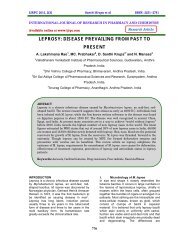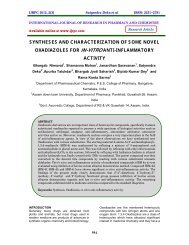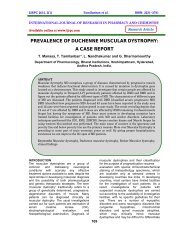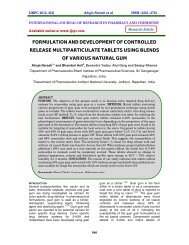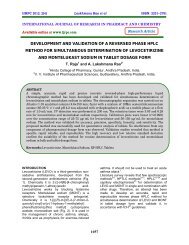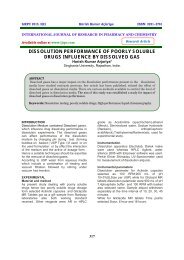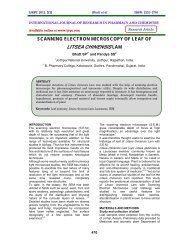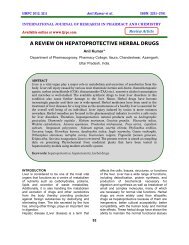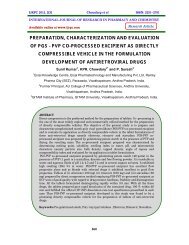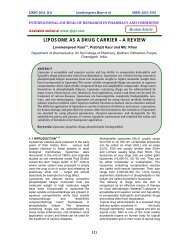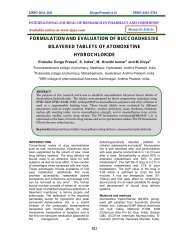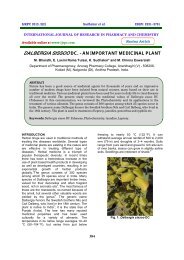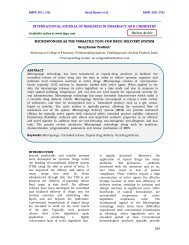design, synthesis and biological evaluation of structural hybrids - ijrpc
design, synthesis and biological evaluation of structural hybrids - ijrpc
design, synthesis and biological evaluation of structural hybrids - ijrpc
Create successful ePaper yourself
Turn your PDF publications into a flip-book with our unique Google optimized e-Paper software.
IJRPC 2012, 2(1) Sudheendra et al. ISSN: 22312781<br />
INTERNATIONAL JOURNAL OF RESEARCH IN PHARMACY AND CHEMISTRY<br />
Available online at www.<strong>ijrpc</strong>.com<br />
Research Article<br />
DESIGN, SYNTHESIS AND BIOLOGICAL EVALUATION OF<br />
STRUCTURAL HYBRIDS OF NITROGEN HETEROCYCLES:<br />
REACTIONS OF SUBSTITUTED 5-MERCAPTO-1, 2, 4-<br />
TRIAZOLES<br />
Sudheendra* 1 , R. H. Udupi 2 <strong>and</strong> V. Himabindu 3<br />
1 Post Graduate Department <strong>of</strong> Pharmaceutical Chemistry, Luqman College <strong>of</strong> Pharmacy,<br />
Gulbarga, India<br />
2 Department <strong>of</strong> Pharmaceutical Chemistry, N.E.T. Pharmacy College, Raichur, India.<br />
3 Centre for Environment, IST, JNT University, Hyderabad, Andhra Pradesh, India.<br />
ABSTRACT<br />
The aryl/aryloxy acid hydrazides (1a 1-a 16) were prepared from their corresponding esters by a<br />
reaction with hydrazine hydrate following known method. These hydrazides were then<br />
converted into their corresponding potassium dithiocarbazinates (2a 1-a 16) by a reaction with<br />
carbon disulphide in presence <strong>of</strong> alcoholic potassium hydroxide. The required 3-aryloxy-4-(Npyrid-4-yl<br />
carboxamido)-5-mercapto-1,2,4-triazoles (3a1-a16) were prepared in excellent<br />
yields in one pot reaction by heating a mixture <strong>of</strong> potassium dithiocarbazinates (2a1-a16) <strong>and</strong><br />
isonicotinic acid hydrazide for 6-8 hr when pr<strong>of</strong>use evolution <strong>of</strong> hydrogen sulphide was<br />
observed. The reaction <strong>of</strong> these triazoles (3a 1-a 16) with 4-amino-1,2,4-triazole in absolute<br />
ethanol furnished 3-aryl/aryloxy methyl-(N-pyrid-4-yl carboxamido)-5-([1,2,4]triazol-4-yl<br />
amino)-1,2,4-triazoles (4a 1-a 16). The compounds have been characterized on the basis <strong>of</strong><br />
elemental analysis <strong>and</strong> spectral data. All the compounds synthesized were evaluated for<br />
antibacterial, antifungal <strong>and</strong> antitubercular activities by following MIC determination method.<br />
The synthesized compounds were shown to possess antifungal <strong>and</strong> antibacterial activities at<br />
one or the other concentrations; it is quite interesting that most <strong>of</strong> the compounds were found<br />
to possess good antitubercular properties also, with varied range.<br />
Keywords: 1,2,4-Triazoles, Antifungal, Antibacterial, Antitubercular.<br />
INTRODUCTION<br />
The chemistry <strong>of</strong> heterocyclic compounds is a<br />
field <strong>of</strong> organic/pharmaceutical chemistry<br />
which is being continuously explored for the<br />
<strong>synthesis</strong> <strong>and</strong> <strong>biological</strong> <strong>evaluation</strong> <strong>of</strong> new<br />
chemical entities in search <strong>of</strong> better lead<br />
molecules. A number <strong>of</strong> heterocyclic systems<br />
incorporating 1,2,4-triazole nucleus fused with<br />
other heterocycles possesses broad spectrum<br />
<strong>of</strong> <strong>biological</strong> activities [1-4] . A literature survey<br />
revealed that substituted 1,2,4-triazoles <strong>and</strong><br />
their N-bridged heterocycles have received<br />
125<br />
considerable attention in recent years as they<br />
are endowed with variety <strong>of</strong> <strong>biological</strong> activities<br />
<strong>and</strong> have wide range <strong>of</strong> therapeutic properties<br />
5-8 . Triazole is a template that is associated<br />
with several <strong>biological</strong> activities thus making<br />
this heterocyclic moiety to occupy a unique<br />
position in heterocyclic chemistry 9 . 1,2,4-<br />
triazoles have been reported to possess antiinflammatory,<br />
analgesic, antiasthmatic,<br />
diuretic, antihypertensive, antibacterial,<br />
antifungal <strong>and</strong> anticholinergic activities [10-14] .<br />
Prompted by the above facts <strong>and</strong> as a part <strong>of</strong>
IJRPC 2012, 2(1) Sudheendra et al. ISSN: 22312781<br />
our program aimed at developing new<br />
<strong>biological</strong>ly active compounds 15-17 , convenient<br />
<strong>synthesis</strong> <strong>of</strong> hitherto unreported title<br />
compounds incorporating N-pyridyl<br />
carboxamido-1,2,4-triazole <strong>and</strong> 4-amino-1,2,4-<br />
triazole moieties together was devised. Apart<br />
from the chemical interest, these compounds<br />
could also be a subject <strong>of</strong> studies as<br />
pharmacological agents.<br />
The aryl/aryloxy acid hydrazides (1a1-a16)<br />
were prepared from their corresponding esters<br />
by a reaction with hydrazine hydrate following<br />
known method [18] . These hydrazides were<br />
then converted into their corresponding<br />
potassium dithiocarbazinates (2a1-a16) by a<br />
reaction with carbon disulphide in presence <strong>of</strong><br />
alcoholic potassium hydroxide<br />
[19] . The<br />
required 3-aryloxy-4-(N-pyridyl carboxamido)-<br />
5-mercapto-1,2,4-triazoles (3a1-a16) were<br />
prepared in excellent yields in one pot reaction<br />
by heating a mixture <strong>of</strong> potassium<br />
dithiocarbazinates (2a1-a16) <strong>and</strong> isonicotinic<br />
acid hydrazide for 6-8 hr when pr<strong>of</strong>use<br />
evolution <strong>of</strong> hydrogen sulphide was<br />
observed [17] . The reaction <strong>of</strong> (3a1-a16) with 4-<br />
amino-1,2,4-triazole in absolute ethanol<br />
furnished 3-aryl/aryloxy methyl-(N-pyridyl<br />
carboxamido)-5-([1,2,4]triazol-4-yl amino)-<br />
1,2,4-triazoles (4a1-a16). The compounds<br />
have been characterized on the basis <strong>of</strong><br />
elemental analysis <strong>and</strong> spectral data. All the<br />
compounds synthesized were evaluated for<br />
their antibacterial, antifungal <strong>and</strong><br />
antitubercular activities by following MIC<br />
determination method.<br />
EXPERIMENTAL<br />
All the compounds in the study were<br />
synthesized by following scheme 1. Melting<br />
points were determined on a Toshniwal<br />
apparatus in open capillaries <strong>and</strong> are<br />
uncorrected. The purity <strong>of</strong> the compounds<br />
was checked by TLC on silica gel-G plates<br />
using chlor<strong>of</strong>orm-ethyl acetate (1:1) solvent<br />
system as irrigant <strong>and</strong> iodine vapor as<br />
visualizing agent. IR spectra in KBr (cm -1 )<br />
were recorded on a Schimadzu FTIR-8000<br />
series spectrophotometer <strong>and</strong> 1 H NMR spectra<br />
(DMSO-d 6 ) on EM 390 MHz spectrometer<br />
using TMS as internal st<strong>and</strong>ard (Chemical<br />
shifts are expressed in δ ppm). Mass spectra<br />
were recorded on a Jeol JMSD-300 Mass<br />
Spectrometer operating at 70 eV. All the<br />
compounds showed satisfactory micro<br />
analytical results for C, H <strong>and</strong> N.<br />
Potassium dithiocarbazinates (2a1-a16) were<br />
prepared by reacting aryl/aryloxy acid<br />
hydrazides (1a1-a16) with carbon disulphide in<br />
126<br />
the presence <strong>of</strong> alcoholic KOH following the<br />
reported procedure (yields were between 75-<br />
82%). A suspension <strong>of</strong> equimolar proportions<br />
<strong>of</strong> the above potassium dithiocarbazinates,<br />
isonicotinic acid hydrazide <strong>and</strong> water (5 ml) on<br />
heating under reflux for 5-6 hr gave 3-<br />
substituted-4-(N-pyridyl carboxamido)-5-<br />
mercapto-1,2,4-triazoles (3a1-a16). Equimolar<br />
reaction <strong>of</strong> the above triazoles with 4-amino-<br />
1,2,4-triazole in absolute ethanol furnished<br />
the required 3-aryl/aryloxy-4-(N-pyridyl<br />
Ar<br />
O<br />
Ar-CONH.NH-C-S - K +<br />
C<br />
N<br />
Ar<br />
N<br />
N<br />
O NH<br />
C<br />
N<br />
[2a 1 -a 16 ]<br />
i<br />
N<br />
[3a 1 -a 16 ]<br />
ii<br />
N<br />
NH<br />
N<br />
S<br />
Isonicotinic acid hydrazide<br />
&water, reflux for 5-6 hrs<br />
N<br />
SH<br />
refluxed in ethanol with<br />
4-N(amino)-1,2,4-triazole<br />
NH<br />
[4a 1 -a 16 ]<br />
SCHEME 1<br />
carboxamido)-5-([1,2,4]triazol-4-yl amino) -<br />
1,2,4-triazoles (4a1-a16).<br />
Synthesis <strong>of</strong> 3-aryl/aryloxy-4-(pyridyl<br />
carboxamido)-5-mercapto-1,2,4-triazoles<br />
(3a1-a16):<br />
A suspension <strong>of</strong> potassium dithiocarbazinates<br />
(2, 0.1 mol), isonicotinic acid hydrazide (0.1<br />
mol) <strong>and</strong> water (5ml) was heated under reflux<br />
for 5-6 hr when hydrogen sulphide was<br />
evolved <strong>and</strong> a clear solution resulted. Dilution<br />
<strong>of</strong> the reaction mixture with cold water (50 ml)<br />
N<br />
N<br />
N<br />
(Ar=Substituted aryl/aryloxy me
IJRPC 2012, 2(1) Sudheendra et al. ISSN: 22312781<br />
<strong>and</strong> subsequent acidification with hydrochloric<br />
acid gave the required product which was<br />
filtered, washed with water <strong>and</strong> crystallized<br />
from aqueous ethanol. The compounds <strong>of</strong> the<br />
series (3a 1 -a 16 ) were prepared following the<br />
same procedure.<br />
3-phenoxy methyl-4-(pyridyl carboxamido)-<br />
5-mercapto-1, 2, 4-triazole (3a6):<br />
IR: 3250 (NH <strong>of</strong> CONH), 3050 (aromatic C-H<br />
stretching), 2910 (OCH 2 ), 2610 (SH), 1665<br />
(CONH), 1635 (NH in plane bending), 1620<br />
(C=N), 1605 (C=C), 1490 (C-N), 1098 (C-O-<br />
C), 740 (mono substituted benzene), 695 (C-<br />
S); 1 HNMR (DMSO-d 6, δ ppm): 5.91-8.82 (11<br />
H, m, 5H <strong>of</strong> aromatic group, 4H <strong>of</strong> pyridyl<br />
group <strong>and</strong> 2H <strong>of</strong> –OCH 2 ), 11.11 (1H, s, 1H <strong>of</strong><br />
CONH), -SH group which generally appears<br />
around 14 <strong>and</strong> above is not observed as the<br />
spectrum is taken in the δ scale <strong>of</strong> 0-14. MS:<br />
m/z 327 (M + ).<br />
3-(2-methyl phenoxy methyl)-4-(pyridyl<br />
carboxamido)-5-mercapto-1,2,4-triazole<br />
(3a13): IR: 3248 (NH <strong>of</strong> CONH), 3066<br />
(aromatic C-H stretching), 2950 (C-H<br />
stretching), 2905 (OCH 2 ), 2608 (SH), 1662<br />
(CONH), 1640 (NH in plane bending), 1615<br />
(C=N), 1608 (C=C), 1486 (C-N), 1130 (C-O-<br />
C), 840 (disubstituted benzene), 700 (C-S);<br />
1 HNMR (DMSO-d 6, δ ppm): 2.51 (3H, s, 3H <strong>of</strong><br />
CH 3 ), 3.42 (2H, bs, 2H <strong>of</strong> –OCH2), 7.79-8.72<br />
(8 H, m, 4H <strong>of</strong> aromatic group, 4H <strong>of</strong> pyridyl<br />
group), a weak peak at 10.1 (1H, s, 1H <strong>of</strong><br />
CONH), 14 (1H, <strong>of</strong> –SH); MS: m/z 341 (M + ).<br />
Synthesis <strong>of</strong> 3-aryl/aryloxy-4-(pyridyl<br />
carboxamido)-5-([1,2,4]triazol-4-yl amino) -<br />
1,2,4-triazoles (4a1-a16) :<br />
Triazole (3, 0.01 mol) <strong>and</strong> 4-amino-1,2,4-<br />
triazole (0.01 mol) in absolute ethanol (50 ml)<br />
were refluxed on steam till the evolution <strong>of</strong><br />
hydrogen sulphide stopped. The solid obtained<br />
was filtered, washed with water, dried <strong>and</strong><br />
crystallized from ethanol. The compounds <strong>of</strong><br />
the series (4a1-a16) were prepared following<br />
the same procedure <strong>and</strong> characterized (Table-<br />
1).<br />
3-(4-chlorophenyl)-4-(pyridyl carboxamido)-<br />
5-([1,2,4]triazol-4-yl amino) -1,2,4-triazole<br />
(4a2): IR: 3256 (NH), 3054 (aromatic C-H<br />
stretching), 2905 (-OCH 2 ), the characteristic<br />
absorption b<strong>and</strong> for SH at 2608 has<br />
disappeared, 1656 (CO <strong>of</strong> CONH), 1632 ( NH<br />
in plane bending), 1610 (C=N), 1602 (C=C),<br />
1478 (C-N), 1140 (C-O-C), 842 (1,4-<br />
disubstituted benzene); 1 HNMR (DMSO-d 6 , δ<br />
ppm): 6.20 (1H, s, NH), 7.55-8.79 (8H, m, 4H<br />
127<br />
<strong>of</strong> aromatic group <strong>and</strong> 4H <strong>of</strong> pyridyl group),<br />
8.81 (2H, s, 2 CH <strong>of</strong> pyridyl), 10.87 (1H, s,<br />
CONH); MS: m/z 368 (M + ).<br />
3-(4-aminophenyl)-4-(pyridyl carboxamido)-<br />
5-([1,2,4]triazol-4-yl amino) -1,2,4-triazole<br />
(4a5): IR: 3268 (NH <strong>and</strong> NH 2 ), 3058 (aromatic<br />
C-H stretching), 2908 (-OCH 2 ), characteristic<br />
absorption b<strong>and</strong> for SH at 2610 disappeared,<br />
1665 (CO <strong>of</strong> CONH), 1632 (NH in plane<br />
bending), 1618 (C=N), 1600 (C=C), 1490 (C-<br />
N), 840 (1,4-disubstituted benzene); 1 HNMR<br />
(DMSO-d 6 , δ ppm): 3.33 (2H, s, NH 2 ), 5.98<br />
(1H, s, NH), 7.55-8.38 (8H, m, 4H <strong>of</strong> aromatic<br />
group, 4H <strong>of</strong> pyridyl group), 8.75 <strong>and</strong> 8.79 (2H,<br />
s, 2H <strong>of</strong> triazole), 11.50 (1H, s, CONH); MS:<br />
m/z 348 (M + ).<br />
BIOLOGICAL ACTIVITIES<br />
Antibacterial <strong>and</strong> antifungal activities<br />
The compounds <strong>of</strong> the series (4a1-a16) have<br />
been subjected to invitro <strong>evaluation</strong> <strong>of</strong> their<br />
antibacterial <strong>and</strong> antifungal activities against<br />
the fungi C<strong>and</strong>ida albicans, Aspergillus<br />
niger <strong>and</strong> against the bacteria<br />
Staphylococcus aureus, Enterococcus<br />
fecalis, Escherichia coli, Klebsiella<br />
pneumoniae by minimum inhibitory<br />
concentration (MIC) method [20] . The results<br />
obtained are tabulated in Table-2.<br />
Antitubercular activity studies<br />
All the compounds in the series (4a1-a16)<br />
have been evaluated for their invitro<br />
antitubercular activity against the st<strong>and</strong>ard<br />
strain <strong>of</strong> Mycobacterium tuberculosis H 37 RV<br />
using Middlebrook 7H-9 broth referring to the<br />
st<strong>and</strong>ard procedure [21] . The results <strong>of</strong> the<br />
antitubercular studies are given in Table-3.<br />
RESULTS AND DISCUSSION<br />
The title compounds were synthesized as per<br />
the scheme described. The potassium<br />
dithiocarbazinates <strong>of</strong> aryl/aryloxy acids on<br />
heating with well known antitubercular drug<br />
isoniazid (INH) furnished the required parent<br />
triazoles namely 3-substituted-4(N-pyridyl<br />
carboxamido)-5-mercapto-1, 2, 4-trizoles.<br />
These on heating with 4-amino-1, 2, 4-triazole<br />
furnished the title compounds in a single step<br />
by the replacement <strong>of</strong> mercapto group at<br />
position 5 <strong>of</strong> parent triazoles with evolution <strong>of</strong><br />
hydrogen sulphide. All the newly synthesized<br />
compounds were analyzed satisfactorily for<br />
their C, H <strong>and</strong> N analysis which showed that<br />
the compounds were having purity <strong>of</strong> expected<br />
range. The characterization <strong>of</strong> compounds<br />
was done on the basis <strong>of</strong> spectral analysis
IJRPC 2012, 2(1) Sudheendra et al. ISSN: 22312781<br />
using IR, 1 HNMR <strong>and</strong> Mass spectroscopic<br />
technique. The compounds were evaluated for<br />
their antifungal, antibacterial <strong>and</strong><br />
antitubercular activities <strong>and</strong> their MIC values<br />
were also determined.<br />
Antifungal Activity<br />
The antifungal activity study results reveal<br />
that, the compounds 4a1, 4a7, 4a9, 4a13 <strong>and</strong><br />
4a15 were the potent amongst triazole<br />
derivatives evaluated, as these have inhibited<br />
the growth <strong>of</strong> fungal strain at 12.5µg<br />
concentration itself against A. niger. The<br />
compounds 4a8 <strong>and</strong> 4a16 have shown<br />
inhibitory activity at 25µg <strong>and</strong> 4a3, 4a6, 4a10,<br />
4a11, 4a12 & 4a14 were active at 50µg where<br />
as 4a2 has MIC <strong>of</strong> 100µg.<br />
Excellent activity against C. albicans has<br />
been shown by the compounds 4a7, 4a8,<br />
4a12 <strong>and</strong> 4a15 at 25µg concentration. The<br />
inhibition <strong>of</strong> the growth at 50µg has been<br />
shown by the compounds 4a1, 4a9 <strong>and</strong> 4a16.<br />
The compounds 4a10, 4a11 <strong>and</strong> 4a13 have<br />
been shown to possess activity at 100µg. The<br />
compounds 4a2, 4a3, 4a6 <strong>and</strong> 4a14 failed to<br />
produce inhibitory activity against C. albicans;<br />
however, both the organisms in the study<br />
found to remain resistant for compounds 4a4<br />
<strong>and</strong> 4a5 at all the concentration levels tested.<br />
Antibacterial activity<br />
Remarkable antibacterial activity has shown<br />
by the compounds 4a6, 4a7 <strong>and</strong> 4a13 at the<br />
concentration <strong>of</strong> 6.25µg which is followed by<br />
the compounds 4a12 <strong>and</strong> 4a15 at 12.5µg<br />
concentration against S. aureus. The activity<br />
at 25µg concentration has been shown to be<br />
possessed by the compounds 4a3 & 4a8<br />
against S. aureus <strong>and</strong> the compounds 4a2,<br />
4a8, 4a9 & 4a10 against E. coli. All the<br />
compounds showed to possess activity<br />
against E. coli either at one or the other<br />
concentration tested. The compound 4a9 did<br />
not show any activity against all the organisms<br />
tested except E. coli. The MIC for the<br />
compounds to show activity against E. fecalis<br />
was not below 50µg <strong>and</strong> the organism was<br />
resistant for the compounds 4a9, 4a14 <strong>and</strong><br />
4a15 even at 100µg concentration. All the<br />
compounds have shown their growth inhibitory<br />
activity against K. pneumoniae only at 100µg<br />
concentration except the compounds 4a4, 4a5<br />
<strong>and</strong> 4a9 for which the organism remained<br />
resistant even at 100µg concentration.<br />
Antitubercular activity<br />
In our present work the synthesized<br />
compounds were also investigated for their<br />
property as antitubercular agents using Alamar<br />
Blue Dye technique. The MIC values were<br />
determined for each compound which gives<br />
the lowest drug concentration that prevented<br />
the colour change from blue to pink. The<br />
superior antitubercular activity was shown by<br />
the derivative 4a15 at 0.8µg itself. The<br />
compounds 4a10 <strong>and</strong> 4a12 shown growth<br />
inhibitory activity at 3.125µg where as the<br />
compound 4a1 possessed MIC at 6.25 µg.<br />
The MIC for the compounds 4a11, 4a13, 4a14<br />
&4a16 was found to be 12.5µg <strong>and</strong> that for the<br />
compounds 4a4, 4a5, 4a7 & 4a8 was 25µg.<br />
The remaining compounds have showed to<br />
possess the MIC at 50µg except 4a2 which<br />
has showed growth inhibitory activity only at<br />
100µg concentration.<br />
CONCLUSION<br />
Though, in general the synthesized<br />
compounds were proved to possess activity at<br />
one or other concentrations in the activities<br />
such as antifungal, antibacterial <strong>and</strong><br />
antitubercular, it is quite interesting to note that<br />
most <strong>of</strong> the compounds were found to possess<br />
good antitubercular properties with varied<br />
range. However 4a15 was found to possess<br />
excellent antitubercular activity at the<br />
concentration as low as 0.8µg. The results<br />
indicate that, slight modification in the<br />
structure <strong>of</strong> the molecule by carryingout<br />
addition or elimination <strong>of</strong> suitable functional<br />
groups may result in useful therapeutic agents.<br />
Further study on the compounds containing<br />
this type <strong>of</strong> moiety is quite reasonable <strong>and</strong><br />
desirable.<br />
ACKNOWLEDGEMENTS<br />
The authors express their thanks to Dr. K. S.<br />
Bhide <strong>and</strong> Dr. Venugopal <strong>of</strong> Astra Zeneca<br />
Pharma India Ltd., Bangalore for their kind<br />
help in spectral studies. Authors also thank Dr.<br />
Kishore Bhat, Pr<strong>of</strong>essor <strong>and</strong> Head,<br />
Department <strong>of</strong> Microbiology, Maratha M<strong>and</strong>al<br />
Dental College, Belgaum for the kind help<br />
rendered in carrying out <strong>biological</strong> activities.<br />
128
IJRPC 2012, 2(1) Sudheendra et al. ISSN: 22312781<br />
Table-1<br />
Characterization data <strong>of</strong> 3-aryl/aryloxy-4-(pyridyl carboxamido)-5-<br />
([1,2,4]triazol-4-yl amino) -1,2,4-triazoles (4a1-a16)<br />
Sl.No.<br />
1.<br />
2.<br />
3.<br />
4.<br />
5.<br />
6.<br />
7.<br />
8.<br />
9.<br />
10.<br />
11.<br />
12.<br />
13.<br />
14.<br />
15.<br />
16.<br />
Code<br />
4a1<br />
4a2<br />
4a3<br />
4a4<br />
4a5<br />
4a6<br />
4a7<br />
4a8<br />
4a9<br />
4a10<br />
4a11<br />
4a12<br />
4a13<br />
4a14<br />
4a 15<br />
4a 16<br />
Ar<br />
(substituent)<br />
Molecular<br />
Formula<br />
Molecular<br />
weight<br />
Melting<br />
Point ( 0 C)<br />
Phenyl C 16H 14ON 9 380 223<br />
4-Chloro phenyl C 16H 14ON 9Cl 416 232<br />
2-Chloro phenyl C 16H 14ON 9Cl 416 218<br />
2-Amino phenyl C 16H 16ON 10 396 240<br />
4-Amino phenyl C 16H 16ON 10 396 228<br />
Phenoxy methyl C 17H 16O 2N 9 410 236<br />
2-Nitro phenoxy methyl C 17H 15O 4N 10 455 255<br />
2-Chloro phenoxy methyl C 17H 15O 2N 9Cl 445 228<br />
4-Amino phenoxy methyl C 17H 17O 2N 10 425 239<br />
4-Bromo phenoxy methyl C 17H 15O 2N 9Br 489 254<br />
4-Nitro phenoxy methyl C 17H 15O 4N 10 455 188<br />
4-Methyl phenoxy methyl C 18H 18O 2N 9 424 218<br />
2-Methyl phenoxy methyl C 18H 18O 2N 10 424 242<br />
α-Naphthoxy methyl C 21H 18O 2N 9 460 185<br />
β-Naphthoxy methyl C 21H 18O 2N 9 460 227<br />
2-Isopropyl-5-methyl phenoxy<br />
methyl<br />
C 21H 24O 2N 9 466 245<br />
129
IJRPC 2012, 2(1) Sudheendra et al. ISSN: 22312781<br />
Table-2<br />
Data showing the results <strong>of</strong> antifungal <strong>and</strong> antibacterial activity studies <strong>of</strong> the compounds <strong>of</strong> the<br />
series (4a1-a16) by MIC method<br />
Sl No.<br />
Samples<br />
Antifungal activity<br />
Minimum Inhibitory Concentration (MIC in µg)<br />
Antibacterial activity<br />
C. albicans A. niger S. aureus E. fecalis E. coli K. pneumoniae<br />
1 4a1 50 12.5 50 50 50 100<br />
2 4a2 R 100 50 50 25 100<br />
3 4a3 R 50 25 100 100 100<br />
4 4a4 R R 100 100 50 R<br />
5 4a5 R R 100 100 50 R<br />
6 4a6 R 50 6.25 50 50 100<br />
7 4a7 25 12.5 6.25 50 50 100<br />
8 4a8 25 25 25 100 25 100<br />
9 4a9 50 12.5 R R 25 R<br />
10 4a10 100 50 100 50 25 100<br />
11 4a11 100 50 50 50 50 100<br />
12 4a12 25 50 12.5 50 100 100<br />
13 4a13 100 12.5 6.25 100 100 100<br />
14 4a14 R 50 100 R 50 100<br />
15 4a15 25 12.5 12.5 R 100 100<br />
16 4a16 50 25 50 50 100 100<br />
Table-3<br />
Data showing the results <strong>of</strong> antitubercular activity <strong>of</strong> the compounds <strong>of</strong> the series (4a1-a16)<br />
against Mycobacterium tuberculosis H 37 RV<br />
Sl<br />
No<br />
1.<br />
2.<br />
3.<br />
4.<br />
5.<br />
6.<br />
7.<br />
8.<br />
9.<br />
10.<br />
Samples<br />
130<br />
Concentration in µg<br />
100 50 25 12.5 6.25 3.125 1.6 0.8 0.4 0.2<br />
4a1 S S S S S R R R R R<br />
4a2 S S R R R R R R R R<br />
4a3 S R R R R R R R R R<br />
4a4 S S S R R R R R R R<br />
4a5 S S S R R R R R R R<br />
4a6 S S R R R R R R R R<br />
4a7 S S S R R R R R R R<br />
4a8 S S S R R R R R R R<br />
4a9 S S R R R R R R R R<br />
4a10 S S S S S S R R R R
IJRPC 2012, 2(1) Sudheendra et al. ISSN: 22312781<br />
11.<br />
12.<br />
13.<br />
14.<br />
15.<br />
16.<br />
R=Resistant<br />
4a11 S S S S R R R R R R<br />
4a12 S S S S S S R R R R<br />
4a13 S S S S R R R R R R<br />
4a14 S S S S R R R R R R<br />
4a15 S S S S S S S S R R<br />
4a16 S S S S R R R R R R<br />
S=Sensitive<br />
REFERENCES<br />
1. Singh H, Yadav L D S <strong>and</strong> Sharma K. Agric.<br />
Biol.Chem. 1983; 47:1017-1020.<br />
2. Hosur MC, Talwar MB, Laddi UV, Bennur S<br />
<strong>and</strong>Bennur SC. Indian J. Chem. 1995;<br />
34B:707-712.<br />
3. Udupi RH <strong>and</strong> Purushottamachar P. Indian J<br />
Heterocycl.Chem. 2000;9(4):283-286.<br />
4. Udupi RH, Kulkarni VM, Srinivasulu N <strong>and</strong><br />
Purushottamachar P. J Indian Chem Soc.<br />
2002; 79:381-382.<br />
5. Udupi RH, Ramach<strong>and</strong>ra Setty S,<br />
Srinivasulu N, Pasha TY, N<strong>and</strong>akishore<br />
Agarwal, Shivaraj Gouda T <strong>and</strong> Sunil<br />
Kumar B. Indian Drugs. 2002; 39(6):318-<br />
322.<br />
6. Udupi RH, Ramach<strong>and</strong>ra Setty S,<br />
Srinivasulu N, Pasha TY, N<strong>and</strong>akishore<br />
Agarwal, Shivaraj Gouda T <strong>and</strong> Sunil<br />
Kumar B. Ind J Heterocyclic Chem. 2003;<br />
12 (4): 361-364.<br />
7. Udupi RH, Rajeeva B, Ramach<strong>and</strong>ra Setty<br />
S, Srinivasulu N, Sunil Kumar B <strong>and</strong> Bhat<br />
AR. Ind J Heterocyclic<br />
Chem.,2004;13:229-232.<br />
8. Udupi RH, Rajesh Varnekar B,<br />
Ramach<strong>and</strong>ra Setty S, Srinivasulu N,<br />
Sunil Kumar B <strong>and</strong> Bhat AR. Ind J<br />
Heterocyclic Chem. 2004;4: 39-42.<br />
9. Zech B <strong>and</strong> Croetz H.J Indian Chem Soc.<br />
1981; 280:2923-2926.<br />
10. Udupi RH <strong>and</strong> Bhat AR. Indian J<br />
Heterocyclic Chem, 1996;6:41-44.<br />
11. Udupi RH <strong>and</strong> Purushottamachar P. Ind J<br />
Heterocyclic Chem. 2000;9:189-192.<br />
12. Udupi RH, Purushottamachar P <strong>and</strong> Bhat<br />
AR. Ind J Heterocyclic Chem. 2000;9: 287-<br />
290.<br />
13. Udupi RH, Suresh GV, Ramach<strong>and</strong>ra<br />
Setty S <strong>and</strong> Bhat AR. J Ind Chem Soc.<br />
2000;77: 302-304.<br />
14. Xia Y, Yang ZY, Hour MJ, Kuo SC, Xia P,<br />
Bastow KF, Nakanishi Y, Nampoothiri P,<br />
Hackl T, Hamel E <strong>and</strong> Lee KH, Bioorg<br />
Med Chem Lett. 2001;11:1193.<br />
15. Udupi RH, Kulkarni V M, Sudheendra,<br />
Setty RS <strong>and</strong> Purushottamachar P. Indian<br />
J Heterocycl Chem. 2002;11:303-308.<br />
16. Udupi RH, Srinivasa Rao P <strong>and</strong><br />
Sudheendra. Indian J Heterocycl Chem.<br />
2006; 15:291-292.<br />
17. Udupi RH, Sudheendra, Bheemachari,<br />
Srinivasulu N, Varnekar Rajesh <strong>and</strong><br />
Purushottamachar P. Bull Korean Chem<br />
Soc. 2007; 28(12): 2235-2240.<br />
18. Kakimoto S, Yamamoto K. J Pharm.Soc<br />
Japan. 1954;74:997.<br />
19. Reid JR <strong>and</strong> Heindek MD. J Het<br />
Chem.1976; 13:925.<br />
20. Antimicrobial susceptibility testing<br />
protocols. Schwalve, Moore <strong>and</strong> Goodwin,<br />
Crc Press 2007.<br />
21. Maria C. S. Lourenco, Marcus V. N<br />
deSouza, Aless<strong>and</strong>ra C Pinheiro, Marcelle<br />
de L , Ferreira, Rasnisb B, Goncalves,<br />
Thais Cristina M Nogneira <strong>and</strong> Monica A<br />
Peralta, Evaluation <strong>of</strong> anti-tubercular<br />
activity <strong>of</strong> nicotinic <strong>and</strong> isoniazid<br />
analogues. ARKIVOC 2007;15:181-191.<br />
:<br />
131



